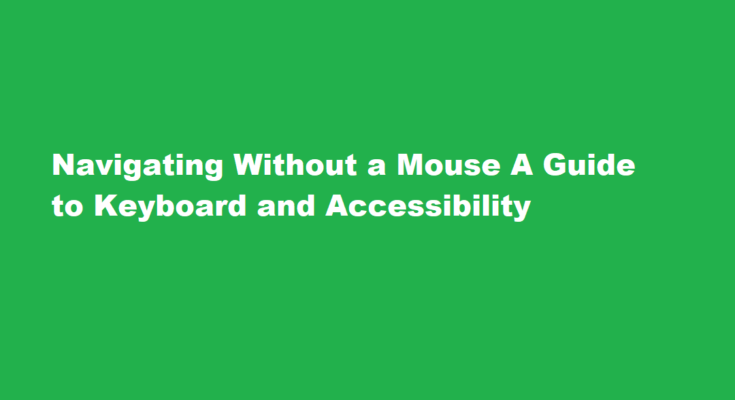Introduction
In today’s digital age, the mouse has long been a staple of computer navigation. However, there are instances where relying solely on a mouse can be inefficient or impractical, such as for individuals with disabilities or during moments when your mouse suddenly stops working. Learning how to navigate without a mouse is a valuable skill that can enhance your productivity and accessibility. In this article, we’ll explore various keyboard shortcuts and accessibility features that allow you to navigate seamlessly through your computer’s operating system and applications.
Mastering Basic Keyboard Shortcuts
Keyboard shortcuts are a powerful tool for navigating your computer without a mouse. Learning some essential shortcuts can make your daily computing tasks more efficient. Here are a few basic keyboard shortcuts to get you started:
Windows Operating System
Alt + Tab – Switch between open applications.
Ctrl + Esc – Open the Start menu.
Alt + F4 – Close the active window.
Windows Key + L – Lock your computer.
macOS
Command + Tab – Switch between open applications.
Command + Space – Open Spotlight to search for files and applications.
Command + Q – Quit the active application.
Command + Option + Eject – Sleep on your Mac.
Exploring System-Wide Accessibility Features
Both Windows and macOS offer a range of accessibility features designed to assist users who have difficulty using a mouse. These features are not only valuable for those with disabilities but can also benefit anyone looking to navigate without a mouse.
Windows
Narrator – A built-in screen reader that reads aloud text on the screen and provides spoken feedback on your actions.
Sticky Keys – Allows you to use keyboard shortcuts by pressing one key at a time instead of simultaneously.
Mouse Keys – Control the mouse pointer using the keyboard’s numeric keypad.
macOS
- VoiceOver – A powerful screen reader that provides detailed spoken and braille descriptions of everything on your screen.
- Keyboard Shortcuts – macOS offers a range of customizable keyboard shortcuts that can be used for various functions, including navigating menus and opening applications.
- Dictation – Enable dictation to control your computer and input text using your voice.
Application-Specific Shortcuts
Most applications come with their own set of keyboard shortcuts, allowing you to perform tasks efficiently without the need for a mouse. Familiarizing yourself with these shortcuts can significantly enhance your productivity. Here are a few examples:
Microsoft Office Suite
Ctrl + S – Save your document.
Ctrl + C – Copy selected text or objects.
Ctrl + V – Paste copied text or objects.
Ctrl + Z – Undo the last action.
Ctrl + F – Open the find and replace dialog.
Web Browsers (e.g., Chrome, Firefox)
Ctrl + T – Open a new tab.
Ctrl + W – Close the active tab.
Ctrl + Tab – Switch between open tabs.
Ctrl + F – Open the find bar to search for text on a webpage.
Using Command Line and Terminal
For advanced users and programmers, command-line interfaces provide powerful navigation options. Windows has the Command Prompt, while macOS has the Terminal. Here, you can navigate through your file system and perform various tasks using text-based commands. Learning these commands can be immensely beneficial for mouse-free navigation.
Assistive Technology
For individuals with disabilities, there are specialized assistive technologies available. Screen readers, braille displays, and head-tracking devices can provide alternative methods of navigating and interacting with computers. These technologies are tailored to meet specific needs and offer a wide range of possibilities for mouse-free navigation.
Frequently Asked Questions
How do you navigate without a mouse?
To move your cursor between objects or fields in a window (such as a dialog box), use Tab , spacebar , arrow key, and Enter . Tab is usually the default, but if it does not work, try using the arrow keys. If you need to press a button, such as OK or Cancel, press spacebar or Enter .
Which key locks the cursor?
Most Windows PC keyboards come with a scroll lock key. You can use this key to toggle the cursor lock on and off. Pressing this key will lock the cursor to a particular computer, and then pressing it again will release the lock.
Conclusion
Navigating without a mouse is not only a useful skill but also an essential aspect of accessibility. Whether you’re temporarily without a working mouse, want to boost your productivity, or have specific accessibility needs, mastering keyboard shortcuts and exploring system-wide and application-specific features can make your computing experience more efficient and enjoyable. Remember, practice is key to becoming proficient in mouse-free navigation, so don’t hesitate to start incorporating these techniques into your daily computing routine. By doing so, you’ll be well on your way to becoming a more versatile and empowered computer user.
Read Also : Navigating Your Way A Comprehensive Guide to Command Prompt Folder Navigation



